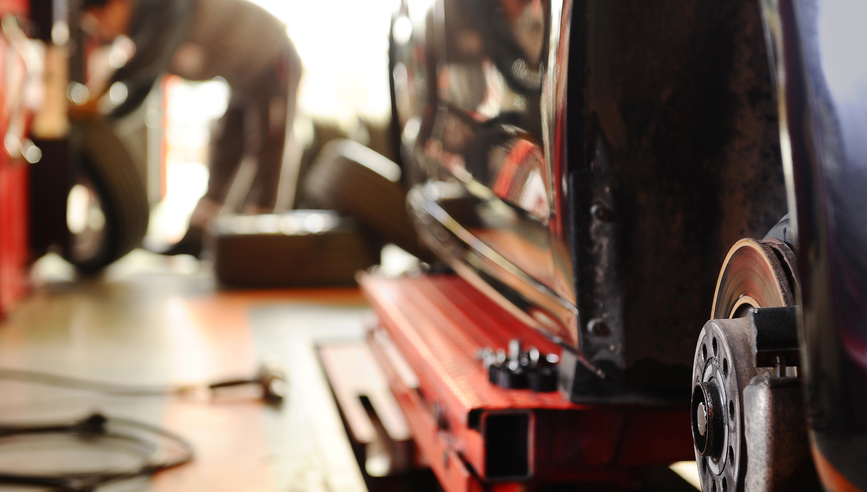Fire Safety for Repair Garages


Repair garages face many hazards, including losses resulting from fire. The combination of fuel, hot work, welding, tires, and combustible and flammable materials in one location makes fire an ever-present threat. To help reduce the risk, it’s important to understand some of the common causes of repair garage fires and tips for keeping the workplace safe.
Fuel drainage and transfer
Fuel-related repairs, such as servicing or replacing a fuel pump, often require technicians to drain or remove a vehicle’s gas tank. Working with fuel presents the risk of fire or explosion. Gasoline vapor is particularly flammable. It can flow invisibly along the ground and ignite from a spark, static electricity, lit cigarette or other heat source.
To help reduce the risk of an accident, follow these precautions when transferring fuel:
- Drain fuel outdoors, if possible, or in a well-ventilated indoor location.
- Make sure the work area is away from flames, sparks and other heat sources.
- Use enclosed pumping equipment or an approved gas caddy. Gas caddies should have safety features that include a fill gauge, grounding cable, and shut-off valve to prevent overflow.
- Be sure the fuel tank is completely drained before beginning vehicle repairs.
- Store drained fuel in ULC-approved storage containers.
Storage of flammable and combustible liquids
Repair shops routinely handle a range of hazardous liquids, from motor oil, brake fluid and lubricants to windshield washer fluid, cleaning agents and other solvents. Many of these liquids are flammable or combustible, especially in indoor settings. Body work, in particular, involves the use of highly volatile paints, varnishes, lacquers, and thinners.
To safely manage these liquids, familiarize yourself with their safety data and store them properly:
- Keep liquids in sealed containers that are in good condition and properly labeled.
- Maintain separate storage areas for incompatible materials.
- Ensure storage areas are well-ventilated and away from flames, sparks, and other heat sources.
- Use proper storage equipment, such as ULS-approved flammable liquids cabinets, double-walled metal drums, and Intermediate Bulk Containers (IBC).
- Maintain containment safeguards to prevent spills.
Storage of compressed gas
Gases stored in high-pressure cylinders, such as compressed oxygen and acetylene for welding, contain a significant amount of stored energy. If the pressure is suddenly released, the cylinders can become missile-like projectiles that can cause significant injury and property damage.
Safe cylinder storage is essential:
- Store cylinders upright in a location where they will not be subject to physical damage, flames, sparks and other heat sources.
- Secure cylinders with a chain or cable.
- Maintain a minimum distance of 6 metres between oxygen cylinders and flammable gas cylinders such as acetylene.
- Close cylinder valves when work is finished and when cylinders are empty or being moved.
Tire storage
Tires require high temperatures to ignite, but if they catch fire, the fire can spread quickly and be difficult to extinguish. Burning tires also produce toxic smoke that is hazardous for people and the environment.
When storing tires on your premises:
- Minimize the number of tires you store. The greater the number of tires, the greater the potential damage should a fire break out.
- Store tires outside, if possible, away from the building and within a secured shipping container.
- If tires are stored indoors, the best practice is to equip the area with automatic sprinklers that are designed for the space and your specific tire storage needs.
Hot work operations
“Hot work” includes torch cutting, welding and grinding metal. These operations produce sparks, molten slag and conductive heat that are ignition sources both during the task and well after it’s completed.
To help prevent fire, establish a formal hot work management plan that includes these key loss control practices:
- Designate a work area that is well-ventilated and removed from all combustible and flammable materials for a radius of 10 metres.
- Before beginning work, clear the area of any potential fire hazards, such as vehicle insulation or upholstery, leaking fluids or residual spills.
- Keep the work area clean, tidy and washed down during and after work.
- Require a fire watch for at least 60 minutes after any hot work is completed.
- Keep appropriate fire extinguishers (rated not less than ABC) available and easy to access.
Spray paint booths
Paints, solvents and cleaning agents used inside a spray booth are highly flammable and can easily catch fire if they come in contact with an ignition source. Even water-based paints can leave a residue that can spontaneously combust.
A properly installed and maintained spray paint booth can reduce the risk of fire:
- Install an enclosed booth that is prefabricated for spray paint purposes. The booth should be fully equipped with a fire suppression system, explosion-proof lighting and duct work that vents directly to the outside.
- Clean the booth regularly to prevent the buildup of overspray residue.
- Replace filters as recommended by the manufacturer.
Oil and solvent soaked materials
Rags, wiping cloths and other absorbent materials that are soaked with oil or other flammable solvents present a special fire hazard. Due to a chemical reaction with oxygen in the air, these materials can become heated through oxidation and spontaneously burst into flames.
To lower the risk of spontaneous combustion:
- Store oil and solvent soaked rags in air-tight, self-closing metal containers that are ULC approved.
- Keep the storage containers away from any other flammable sources and empty them daily.
Fire prevention training
Fire prevention is everyone’s job. Managers should understand fire codes and recognize potential hazards. All employees should be trained in fire safety protocols and know how to respond in the event of a fire emergency.
To help build a fire safety culture:
- Develop and implement formal fire prevention policies and procedures.
- Require new hires to complete fire prevention training before they begin working in the garage, and to require all employees to undergo an annual review of safety practices and the fire prevention policies and procedures.
- Supervise new hires closely until they consistently follow all safe work practices.
- Require employees who perform hazardous jobs, such as spray painting and welding, to be properly certified.
It may not be possible to eliminate the risk of fire completely, but these guidelines along with good general housekeeping can lower your risk considerably. Travelers Canada also offers customers additional fire prevention resources and materials through our Risk Control website.
For further information on insurance, please talk to your broker or visit Travelers Canada.


